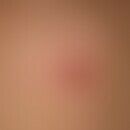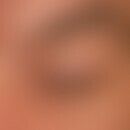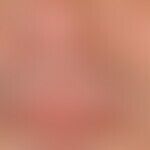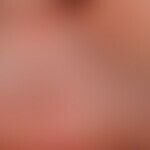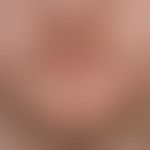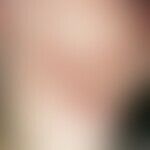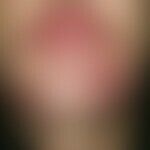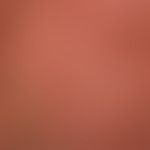Synonym(s)
HistoryThis section has been translated automatically.
DefinitionThis section has been translated automatically.
Frequent, bearded, bacterially induced, acute or chronic superficial folliculitis.
S.a. Impetigo Bockhart (superficial folliculitis).
You might also be interested in
PathogenThis section has been translated automatically.
EtiopathogenesisThis section has been translated automatically.
Infection with Staphylococcus aureus, spread of the pathogen by shaving.
ManifestationThis section has been translated automatically.
Men ; Age: 20-60 years
LocalizationThis section has been translated automatically.
Beard area on chin, lips and cheeks.
ClinicThis section has been translated automatically.
Succulent follicular and also extensive, deep red erythema and red plaques with numerous disseminated or grouped inflammatory follicular papules and pustules, but which may also confluent to larger bumpy beds or nodes Painfulness and burning, especially when shaving.
Follicular pyoderma can lead to irreversible (scarring) hair loss, so that differently configured alopecia foci can develop.
Differential diagnosisThis section has been translated automatically.
Chronic follicular trichophytia: significantly more infiltration; mainly located on the lower legs.
General therapyThis section has been translated automatically.
External therapyThis section has been translated automatically.
Internal therapyThis section has been translated automatically.
Progression/forecastThis section has been translated automatically.
Chronic course with tendency to recur. Tendency towards eczematization(folliculitis eczematosa barbae).
LiteratureThis section has been translated automatically.
- Alibert L (1825) Déscription des maladies de la peau. 2nd edition (Paris, elections) Vol 2: 214
- Anliker D, Itin P (2003) Herpetic folliculitis barbae - A rare cause of folliculitis. dermatologist 54: 265-267
- Eley CD, Gan VN (1997) Picture of the month. Folliculitis, furunculosis, and carbuncles. Arch Pediatric Adolesc Med 151: 625-626
- Naysmith L et al (2001) Multigeminate beard hairs and folliculitis. Br J Dermatol 144: 427-428
- Perry PK et al (2002) Defining pseudofolliculitis barbae in 2001: a review of the literature and current trends. J Am Acad Dermatol 46: S113-119
- Wall D et al (2014) Infection of the Beard area. Kerion: a review of 2 cases. Ir Med J 107:219-221
Incoming links (13)
Alibert mentagra disease; Candida folliculitis; Folliculitis barbae; Folliculitis gramnegative; Folliculitis of the beard region; Folliculitis superficial; Folliculitis (superficial folliculitis); Povidone-iodine solution 10%.; Quinolinol sulphate monohydrate solution 0,1 % (nrf 11.127.); Shaving lichen; ... Show allOutgoing links (10)
Antibiotics; Candida folliculitis; Folliculitis eczematosa barbae; Folliculitis gramnegative; Folliculitis (overview); Folliculitis superficial; Potassium permanganate; Povidone-iodine solution 10%.; Staphylococcal infections; Tinea barbae;Disclaimer
Please ask your physician for a reliable diagnosis. This website is only meant as a reference.



